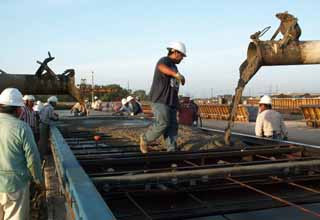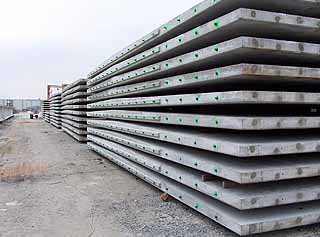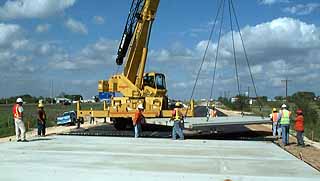|
Subscribe / Renew |
|
|
Contact Us |
|
| ► Subscribe to our Free Weekly Newsletter | |
| home | Welcome, sign in or click here to subscribe. | login |
Construction
| |
 |
June 2, 2006
Open roads quickly with precast pavement
The Transtec Group
Portland cement concrete has long been a proven material for durable pavements, providing at least 30 years of service life with minimal maintenance. One of the issues with concrete pavement, however, is the curing time required for the material to reach adequate strength before it can be opened to traffic.
In urban areas, where pavement construction (or reconstruction) is often limited to short, overnight or weekend windows of time, concrete pavement is often ruled out in favor of hot-mix asphalt pavement. While "fast-setting" concretes have been developed to address this issue, there is still some question as to the long-term durability of these mixtures and the cost is substantially higher than conventional concrete.
There is an alternative solution -- precast concrete pavement.
| How to pave a highway in record time |

Precast pavement panels are made at a fabrication plant under strict quality control standards.
|

Panels are stockpiled and allowed to cure at the plant prior to shipment to the jobsite.
|

Panels can span the full width of a roadway, with some up to 38 feet long.
|
Precast concrete pavement eliminates the need for on-site cure time by using prefabricated concrete panels. The panels are made at a specialized precasting facility ahead of time, then hauled to the construction site and installed as needed. The result is a pavement that can be opened to traffic almost immediately after panel installation, without compromising the durability and long-term performance of the pavement.
Precast concrete is not a new idea. For more than half a century, precast has been used for bridge and commercial building construction with great success. Only until recent years, however, has it also been used for pavements.
Over the past several years, the Federal Highway Administration has been leading an effort to familiarize state highway agencies and paving contractors with precast pavement technology. So far, projects have been constructed in Texas, California and Missouri under FHWA efforts.
Additional projects are being developed in Iowa, Indiana and Texas. Each of these projects has demonstrated some new potential application for precast concrete pavement.
Benefits
Precast pavement offers numerous benefits over conventional cast-in-place concrete pavement. The biggest economic benefit is realized through savings in user delay costs. These are costs borne by the users of a roadway that are directly attributable to construction. Lost work time, increased fuel consumption, increased air pollution, and increased vehicle wear and tear are just a few of these costs.
Precast pavement allows construction to take place during off-peak travel times, such as at night or during weekends, ensuring that the road can open for rush-hour traffic.
In addition to the benefit of reduced user delays, precast concrete offers numerous potential benefits in terms of improving pavement performance. Precast fabrication plants offer a great deal of quality control over the manufacturing process, helping to ensure a very high quality product. Concrete mixture variability is minimized and the curing process can be carefully controlled to ensure a long-lasting product.
Furthermore, precast fabrication plants permit the use of prestressed concrete.
Prestressed, precast
Concrete is naturally strong in compression and relatively weak in tension. Therefore, most concrete "failures" are the result of cracks that form under tension.
Prestressing takes advantage of concrete's inherently high compressive strength. It is a process of using high-strength steel bars and strands to "compress" the concrete, minimizing or even eliminating tensile stresses that can lead to cracking.
Prestressed concrete, like precast concrete, is not a new idea and has been used on bridges and commercial buildings for several decades.
By prestressing precast pavement panels, cracking and the maintenance associated with cracking can be greatly minimized or even eliminated. Additionally, prestressing permits the use of thinner precast panels, saving material, reducing the weight of the panels, and permitting in-kind replacement of existing pavement slabs that may be thinner than required for current traffic.
Success stories
Recently completed projects in Texas, California and Missouri have demonstrated the viability of precast, prestressed pavement construction. A 2,300-foot-long long section of frontage road, using 339 precast panels, was constructed in Texas in 2001 and is performing excellent to date.
A 250-foot-long section of Interstate 10 near Los Angeles was constructed during nighttime hours in 2004. Last year, a 1,000-foot-long section of Interstate 57 was reconstructed near Sikeston, Mo., using 100 precast prestressed concrete panels.
Additional projects are being developed in Iowa, Indiana and Texas. These projects will demonstrate the use of precast pavement panels for bridge approach slabs, weigh-in-motion scale installation and for thinning pavement sections beneath overpasses.
Precast pavement is a hybrid technology, merging the precast concrete and concrete paving industries. As such, there is still unfamiliarity and uncertainty with this unique construction technique. Through current efforts, however, it is hoped that this promising technology will soon gain widespread acceptance.
As it applies to pavement construction and rehabilitation, the catchphrase, "Get in, get out, and stay out" is no longer just a good idea, it is now a requirement in urban areas with high traffic volumes. This necessitates a technique that not only permits rapid construction with minimal traffic disruption, but also provides a long-term pavement solution and not a just a quick-fix.
While precast concrete pavement does not yet have a long-term performance record, it has shown great promise as a construction technique that will reduce traffic delays caused by construction.
For more information on precast pavement, visit http://www.precastpavement.com.
David K. Merritt, PE, is a project manager with the Transtec Group, an Austin, Texas-based pavement engineering firm. He specializes in precast concrete pavement research and development.
Other Stories:


